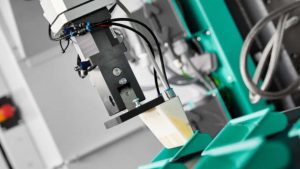
To mimic the dexterity of human hands, robot grippers have undergone significant advancements to pick and place a variety of products ever more deftly. Many of these advances were based on giving robot grippers a softer touch when it comes to moving fruits, baked goods, and other less-rigid materials.
But what about injection-molded and 3D-printed parts and components with complex geometries or smooth and less angular products that may not have a surface area suitable for picking by existing grippers? With the rise in custom part production accelerating with the wide availability of 3D printers, this is an increasingly common issue facing part manufacturers.
Adding to this, in many injection-molding processes, parts fall out of the injection molding machine into a catch pan. While this is fine for many parts, those with curved forms can be damaged by this drop.
Another issue that must be managed by robot grippers in such applications is the separation of the sprues (through which the molten plastic flows into the mold) from the parts.
Read more: Robot Grippers Adapt to 3D Printing and Injection Molding